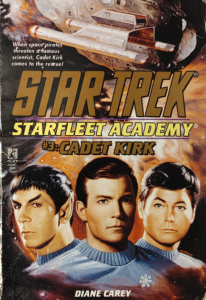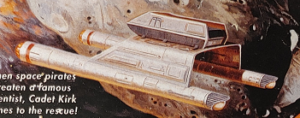 In today’s episode, Jimmy Kirk is an uptight starched-shirt who treats regulations like gospel. But he’s also a loose cannon who plays by his own rules? He’ll have to figure out which one he is if he wants to escape a hostage situation with his and his new friends’ lives intact. Does Diane Carey like children? Can they handle her usual onslaught of nautical jargon? And where does the Zodiac rank on the “ugliest starships” list? All this and more in Cadet Kirk, the book for swingin’ swingles.
In today’s episode, Jimmy Kirk is an uptight starched-shirt who treats regulations like gospel. But he’s also a loose cannon who plays by his own rules? He’ll have to figure out which one he is if he wants to escape a hostage situation with his and his new friends’ lives intact. Does Diane Carey like children? Can they handle her usual onslaught of nautical jargon? And where does the Zodiac rank on the “ugliest starships” list? All this and more in Cadet Kirk, the book for swingin’ swingles.
Cadet Kirk
Author: Diane Carey
Pages: 126
Published: October 1996
Timeline: About 14 years before the 5YM
Prerequisites: None
A very tightly wound, by-the-book cadet won’t let McCoy or even Spock board his shuttlecraft. He has his orders: he’s supposed to be chauffeuring none other than Dr. Richard Daystrom, the vaunted computer genius, to Colony Cambria for the Starfleet Academy Science Conference. (No word on Colony Coheed’s involvement in the event.) It takes the cadet a full ten (10) percent of the book to be convinced and accept that his orders have changed, and when he finally does, he’s none too pleased about it. And just who is this grumpy, rules-obsessed cadet? Why, it’s a young man by the name of James Tiberius Kirk. Now you know … some of the story.
A tractor beam from an automated outpost pulls them off course. Spock smells shenanigans, since it makes no sense for an automated station to have or do that, and since Kirk was originally supposed to be escorting Daystrom, Spock surmises that they’ve been intentionally targeted. He suggests allowing themselves to be drawn in so they can learn more, but Kirk thinks they should take a risk and perform a crash landing so that they can call the shots rather than whoever’s dragging them in. And over Spock’s protests, he does exactly that.
But then once they’ve crash-landed, Kirk immediately switches back to insisting on regulations by arguing that they should send out a mayday signal, which Spock correctly points out will get them found a lot sooner than they want to be. Once again, with Spock officially lodging his dissent, they do what Kirk wants, and of course Spock is right. They get found, and the group who tractored them in, led by a space pirate by the mildly amusing name of Joe Swingle, takes Spock hostage when he attempts to negotiate with them. Left to their own devices, Jim and Leonard retreat into the hills, where they must plan their next moves carefully if they hope to get out of this jam alive.
As you might have noticed, Kirk vacillates wildly between clinging steadfastly to regulations and going out on a limb without warning. It’s jarring, though cleared up somewhat when Kirk admits he’s struggling to find the balance between following the rules and improvising. Regardless, it isn’t the main issue. The problem is that there’s some really easy setup that could have been done to make it make more sense, but wasn’t. The thing is, there’s actually precedent for a portrayal of James Kirk as a mega-weenie rule-follower. Diane Carey wrote it herself. It was called Best Destiny. If you remember that book, you know that young Jimmy Kirk was an incorrigible hoodlum until his father George dragged him along on a deep-space voyage, and poof! One double date with danger and death later, Jimmy appreciated both his father and the value of rules and protocol a little more. That sort of background would have come in really handy for informing Jimmy’s motives and actions here. Does it ever come up? It does not.
Many of the Starfleet Academy books wind up being not much more than “here’s an adventure this character had as a kid”, but at their best, they’re able to take a snapshot of the precise moment a character comes into their own and becomes That Character. Best Destiny sort of already did that, but for one thing, I didn’t like it that much (putting me severely in the minority among a certain breed of Trek novel fan, but I stand by it), and anyway, it’s different approaching it for kids. Witnessing the moment that makes James Kirk into James Kirk is and can be a powerful thing, but there are are two things working against it here. One, I think this book came around right smack in the middle of the time when TOS was starting to become a much tougher sell for kids, what with its cast having recentishly had their final hurrah and passed the torch to a more widely beloved bunch, not to mention other spinoffs beginning to stake their claims. And two, it’s the kind of thing Diane Carey is a lot better suited to making meaningful for older fans, especially ones named Diane Carey.
Most people can’t write like anyone other than themselves, which is hardly a crime, and I’m not saying it’s bad here even. But there’s something undeniably funny about Carey not even being able to put away the nautical tradition and terminology when talking to children.1 And there’s more comedy gold where that came from: after some boilerplate talk about the book itself in Voyages of Imagination, Carey freely and tersely admits: “Cadet Kirk was the only YA I wrote for Star Trek, and I only did it because they asked me. I had no intention of writing any more books for the YA line.” Speculating about what Diane Carey is like as a person has gotten people mad at me before, but I mean, come on: it really sounds like she doesn’t like children all that much, right? I’m not judging her (this time, anyway); I’m just saying maybe she wasn’t the optimal choice for this job.
Despite all that, Cadet Kirk isn’t actually too bad. It’s the stuff driving and surrounding it you get to thinking about that really drags it down, which, funnily enough, makes it very similar in that way to Best Destiny. But that’s the last of the three TOS-based Starfleet Academy books, and looking back on them as a unit, you can see that it was kind of a tough nut for their various authors to crack. Brad and Barbara Strickland had the most “success”, even if their formula didn’t work quite as well for Spock as it did for Picard. It’s hard not to admire anyone who takes a whack at the formidable puzzle of making the rise of the TOS power trio exciting for young readers, but I don’t really think any of these authors were up to it, sadly.
MVP & LVP
- MVP for this book is Spock. It is a mildly interesting tweak that as the ranking officer, he is at least nominally in charge of the mission, though of course necessity dictates that Kirk must assert himself as the true leader. Still, his actions make a lot more sense than Kirk’s most of the time, and I enjoyed him more as a character, even if a surprising chunk of his dialogue sounded not quite right to the ear.
- My LVP for this round is McCoy. He’s just kind of here to round out the power trio, lands somewhere in the middle between Spock and Kirk, and as a result kind of ends up being a big nothing. Kirk may have been all over the place, but he at least had an impact.
Stray Bits
- Anyone hoping for any significant nods to Aftershock is going to be a bit disappointed. McCoy faintly recognizes Kirk from the football incident, but that’s the only real nod to it. It would have been funny for the story to split off from when McCoy and Kirk got punished and follow Kirk’s assignment to the mess hall, watching him whip it into shape in his command style, but we got this instead.
- I rarely have complimentary things to say about Todd Cameron Hamilton’s artwork, but he’s actually not bad at drawing Kirk. It’s 35-year-old TOS-era Shatner, not the 17-year-old the book says he is, but I’m still gonna give him full credit on this one.
- Am I nuts, or is the Zodiac one of the butt-ugliest and most pointless starship class designs ever? Get a load of that thing down there. It is literally just a shuttlecraft on top of a platform with warp-capable nacelles. Garbage. Hot garbage. It’s so bad, I’m literally almost mad at Kirk for getting choked up about it being his “first command”.

Final Assessment
Average. Cadet Kirk isn’t as informed by Best Destiny as it should be—despite Diane Carey’s claim that she basically just ported Kirk over from that novel—and so Kirk just kind of careens back and forth between following the rules and breaking them, which feels like a jarring inconsistency until he explains why he’s doing it, though that doesn’t make it retroactively any less sloppy. I’ve stated many times how no one’s writing is more directly impacted by wanting to be literally anywhere else than Carey’s, and that rears its head in certain ways here as well. Despite all of that, however, it’s not that bad an adventure—but it could have been a lot more.
NEXT TIME: DS9 novels break out of the “between seasons 3 and 4” limbo with The Heart of the Warrior


Adam Goss
The shuttle on the cover is a TOS version of the Vulcan warp shuttle Surak seen in The Motion Picture.